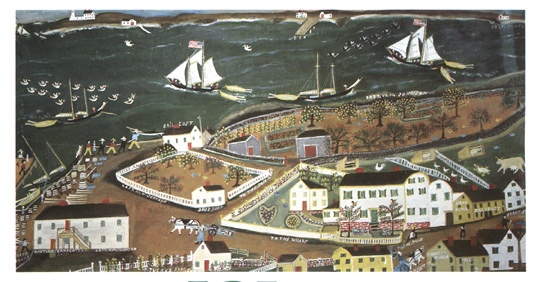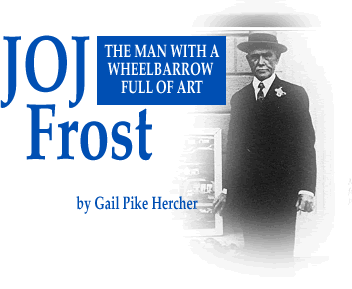|
J.O.J. Frost called Marblehead "the best place on
Earth to live" and once said he did not think there was ever a
person who thought more of the old town and its people than he did.
In 1922, when he was 70 years old, Frost became an artist because he
wanted to preserve what he knew of Marblehead history. During the last
six years of his life, he completed about 130 paintings and 40 wood
carvings -- but he could not sell any of his paintings, not even for
50 cents.
Today he is considered an important native artist. Frost paintings sell
for several thousand dollars, and examples of hsi work hang in many
American museums. In 1953, the Smithsonian Institution included Frost
paintings in a traveling exhibition of American native art on European
tour. Three of his works were on view this spring at the Whitney Museum
in New York.
Born in Marblehead on January 2, 1852, John Orne Johnson Frost went
to sea as a young man, first aboard the fishing schooner Josephine in
1868 and then aboard Oceania in 1869. When he married Amy Anne Lillibridge,
who was known as "Annie," Frost gave up fishing.
For the first time, he worked as a carpenter's apprentice before joining
his father-in-law in the restaurant business. (Lillibridge's restaurant
was one of the first in town to sell friend clams.)
After a lengthy illness, Frost retired in 1865 and joined his wife in
raising sweet peas and flowers for which she was famous, selling them
to the well-established summer community in Marblehead.
Annie and J.O.J. were very much in love and when she died in 1919, J.O.J.
was grief stricken. Although his son and daughter offered to keep house
for him, Frost preferred to live alone. After a time, his basic optimism
prevailed and he was again tending to his garden, cooking and keeping
friends busy and entertaining visitors with his beguiling stories.
But J.O.J. still felt empty. To fill the void left by Annie's death
and to help preserve Marblehead history, he took up painting. Using
any materials at hand, Frost created pictorial stories of old Marblehead
and scenes from his early life at sea. He branched out into making wooden
models of ships, buildings, birds, and fish. He even modeled the "flakes,"
or the drying racks that once lined Marblehead's shore and were used
to prepare salt cod.
J.O.J. Frost is known as a folk artist because he painted for the common
person rather than the wealthy and cultural elite, and although Frost
attended no art school and never studied the principles of perspective
and color, he understood how to use stylized forms, design, pattern
, and a directness in which subtleties are absent. Frost was not concerned
with depicting Marblehead history formally. Rather, he gave it his personal
interpretation.
One charm of folk art, and Frost's in particular, is the lack of pretense.
The works have no heavy overlay of deep psychological meaning and no
abstruse illusions to past artists. Instead, there is an innocent clarity
similar to a child's art, which can often be ruthlessly honest.
Frost does not disguise the fact that he is educating his audience.
His fish carvings were labeled with the specie's name and his paintings
include captions for events or landmarks. His simple lettering showed
where fish fries were held, where flags were raised, and where roads
and buildings were in the old days.
Folk artists commonly pay close attention to detail, making their work
a valuable source of historic information. Frost's art, for instance,
reveals such practices as how to shoot coot and how a fisherman had
to stand up in a dory to defend himself and his catch from the sharks
that would appear alongside. In his journal, he described the latter
activity, saying "you have to hit the shark over the head and numb
him when he comes in -- you've got to know how to stand so the dory
won't tip over -- then the sharks would get you."
Folk art is most often a rural phenomenon. The urban artist tends to
swim in the mainstream, while the rural folk artist (and Marblehead
could be considered rural in those days) paddles happily along in a
side tributary, usually oblivious to the fact that there even is a mainstream.
Frost probably did not know that Impressionism was already 50 years
old, that Matisse and the Fauves, Picasso and Cubism had passed by,
and that Surrealism was in its heyday. Such styles would have been of
little concern to an artist interested in just depicting the past.
Often, Frost pushed his paintings around town in a wheelbarrow and tried
to sell them for a quarter or fifty cents. He would put a few in Litchman's
store but everyone thought Frost was peculiar and did not appreciate
his work.
One time, when Frost had one of his paintings in the window, some of
his old friends in town told him they wished he wouldn't show that picture
in public.
"Why not?" he asked.
"Because," they answered, "it only makes people laugh."
"Well," he said, "if that picture of mine makes people
laugh, it is serving a very useful purpose. So I guess I'll let it stay
right where it is."
In 1924 Frost built a small structure behind his house at 11 Pond Street,
where, for the admission fee of 25 cents, a visitor could see his works,
his collection of Marblehead memorabilia and Indian relics, hear his
stories of old Marblehead and listen to his musical rocks (rocks that
made sounds when struck by a hammer.) Frost was always happy to play
the rocks although he became perturbed if the listener failed to recognize
the tune.
Frost distributed a handbill to announce the opening of his "museum"
on August 13, 1924, and indicated that all proceeds of that day would
benefit the Marblehead Female Humane Society.
According to popular account, no one came. Thereafter, however, the
museum attracted many visitors. For the msot part the visitors came
to hear the famed musical rocks. In fact, the drummer from the Hotel
Brunswick Orchestra in Boston even came to record the sound of the rocks.
These piles of musical rocks were destroyed by a housing developer's
bulldozer in 1966 when the former Frost land was sold for house lots.
Fortunately, some of these rocks were saved and are owned by people
currently living in Marblehead.
Frost must have known what people thought of him and his work, but characteristcally,
he was not bothered by ridicule and continued to paint.
The dapper, eccentric, and independent J.O.J. Frost died on November
3, 1928. During his last years, he had difficulty holding a brush. Often
he forgot to eat and sometimes fainted at his easel. He finished his
last work just a few weeks before he died. His gravestone at Waterside
Cemetary in Marblehead is surrounded by lily-of-the-vally, his favorite
flower.
The story of what happened to Frost's works after his death might have
brought a smile to the old man's face.
His son Frank inherited the collection and gave 80 of the pieces to
the Marblehead Historical Society in 1929. There, they were put into
storage and virtually forgotten. In 1938, a three-week exhibit of some
of the paintings was held at the Jeremiah Lee Mansion, home of the Historical
Society. In 1940, Arthur Heinztelmann, then president of the Marblehead
Arts Association, organised an exhibit of town memorabilia and used
a few of Frost's paintings. The paintings were so well recieved that
the Historical Society put some on permanent display at the Lee Mansion.
In the summer of 1943, Mr. and Mrs. Albert Carpenter, on a visit to
Marblehead from Boston saw Frost's paintings and arranged to meet his
son Frank to buy several of the works. As an art historian, Mrs. Carpenter's
interest in Frost's work must have been apparent to Frank, because when
he died in 1947, he instructed that his father's  pictures
be sold to the couple, which they were. pictures
be sold to the couple, which they were.
In 1948 the Carpenters arranged for an exhibition of Frost's work at
the Institute of Contemporary Art in Boston. The show was well received
and marked the beginning of a broader recognition of Frost as a 20th-century
native painter.
Meanwhile, in 1952, Mr. and Mrs. Frederick D. Mason bought 11 Pond Street,
Frost's old home, and during the renovation discovered 33 more paintings
nailed face to the wall!
Apparently, Frank had used some of his father's paintings as wall covering.
The Masons, believing the paintings to be of some value, arranged for
the Knoedler Galleries in New York and the Child's Gallery in Boston
to display and sell some of the paintings in 1954 to collectors and
museums.
The Mason discovery and sale, however, created quite a legal problem.
The Carpenters maintained that Frank intended for them to receive all
of the Frost works in the house at 11 Pond Street. The Masons claimed
the paintings from the walls were theirs. The dispute was settled in
Essex County Probate Court in 1957. The judge ruled that the paintings
belonged to the Masons, but added that hey would have to relinquish
a carved painted wooden fish and pay the Frost estate $600 which they
had received from the sale of another painted fish. The case was appealed
to the Massachusetts Supreme Judicial Court, but was later dropped.
Frost works were virtually unavailable on the market until 1971 when
45 Frost paintings and carvings fromt eh Carpenter collection were auctioned
by the Parke Bernet Gallery in New York City. Two were sold last year
(1979) at a Salem auction. Not surprisingly, they brought considerably
higher prices than the days when J.O.J. tried to sell them from his
wheelbarrow!
|


